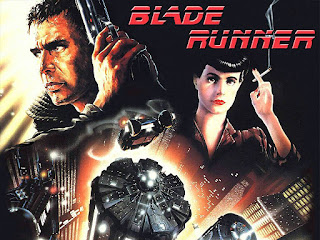A follow-up to the previous post regarding set design and world creation, here are seven (plus one) essential movies that showcase the power that architecture can bring to influencing the lives of people. There's a definite theme to this list, so i've refrained from calling it a "top seven" list. It would be far too complex of an essay to attempt to show how each film uses the built environment to drive plot or set mood, but if you happen to be looking for a good movie to watch anyway, here are a few where you could stand to pay attention to the environment. In most of the examples, there are at least two diametrically opposed philosophies that are reflected in the architecture.
Blade Runner (1982)
Blade Runner, the (loose) adaptation of the Philip K. Dick story Do Androids Dream of Electric Sheep? tells the story of a policeman specialized in hunting down rogue human-like robots known as replicants.
The dirty, crowded streets in which Decker (Harrison Ford) pursues his quarry denies the art deco utopia that the Tyrell Corporation seems to espouse. Of course, the reason this story is such a pillar of the science fiction genre is the questions it raises about our own humanity.
Brazil (1985)
There are similar elements to Blade Runner in Terry Gilliam's black comedy Brazil, particularly in the realm of social divide. However, where Blade Runner waxes dramatic, Brazil dives headlong into the absurd in a mesmerizing dance (both literally and figuratively). The central character, an exceptionally average Sam Lowry struggles to connect with the woman of his dreams while his every effort is thwarted by a totalitarian authority.
Minority Report (2002)
Part of what draws me to include Minority Report in this list is the portrayal of "life as usual" in certain scenes, particularly near the introduction where the concept of precrime is first explained. John Anderton, portrayed here by Tom Cruise, arrests people who are predicted to commit future crimes. This is another Philip K. Dick adaptation, so it's unsurprising that the technological wizardry of "precognition" causes trouble for our brave protagonist.
Unfortunately, what could have been made for an amazing psychological thriller ends with a tedious explanation of what exactly happened. A third Philip K. Dick adaption, A Scanner Darkly, didn't suffer from this unnecessary exposition -- a decision which seems to have been paid for in lost box office sales.
The Matrix (1999)
The Matrix takes Descarte's figurative deceiving demon and conjures it up materially as the machinations of a civilization of, well, machines. The choice of which physical laws can be broken is an interesting one, but because the environment of the Matrix is entirely simulated, the impermanence of the surrounding conditions becomes an obstacle to the crew of the Nebuchadnezzar as much as the pursuing Agents. It's never more clear than after Cypher's betrayal and the subsequent brick infill of every window in a particular building.
If you can bring yourself to watch the sequels, the video-game-esque use of doors that can lead to more than one place highlights some fun implications about the future of virtual space.
Batman (Gotham City 1940-Present)
I've specifically avoided titling this as "Batman Begins" because the real character here is Gotham City. Described by comic juggernaut Frank Miller as "...New York at night" ("Metropolis is New York in the daytime, Gotham City is New York at night."), the city is truly its own character. It seems permanently poised on the edge of collapse, as much from the evil plots of supervillains as from widespread corruption and an ceaseless spree of petty criminality.
Dark City (1998)
As the name might suggest, the city of Dark City is shrouded in a permanent night. The twist that makes this more than a cheap visual trick is that this darkness is a nagging problem that no one seems to understand. John Murdoch, the character who awakens in a bathtub after having apparently committed a particularly brutal murder, seems to hold no more answers than the viewing audience, and we discover the world as he does. The world appears as a silver screen interpretation of Plato's Allegory of the Cave, a metaphor made all the more poignant because the medium is itself presents a closed entity beyond which the characters simply do not exist.
Gattaca (1997)
The idea that humanity can be "improved" runs through most of these films, and Gattaca is no exception. In a society where social status is largely determined by the probability of an exceptional life, Vincent Freeman suffers from the disadvantage that he oughtn't be as exceptional as he is. The struggling lower class world isn't as emphasized here as in previous films on this list, but images of Vincent staring out the atrium windows of the Gattaca launch site (actually the Marin County Civic Center) provide an inspirational backdrop that gives weight to the fear that all this might be taken away.
...honorable mention goes to
Metropolis (1927)
I've heard excellent reviews of this film, but unfortunately i haven't yet seen it, so i can't rightly include it on this list. Many of the themes present in the previous seven films owe their inspiration to Fritz Lang's Metropolis. The central theme revolves around the sharp divide between a hidden working class, an increasingly distant "utopian" elite, and the need to somehow bridge the gap between these two groups.
On a personal note, i'd like to take this opportunity to thank everyone for being patient while F/stop Architectural was on unplanned hiatus. During the break we hit 1,000 unique views! Thank you so much for your support!








Tracking down a copy of Metropolis is totally worth your time.
ReplyDeleteAlso, yay for updates!
I agree, this is a great update (I just found it), and I'm ready for more!
ReplyDelete